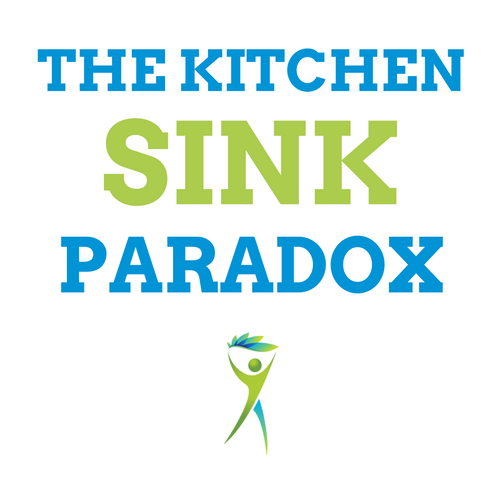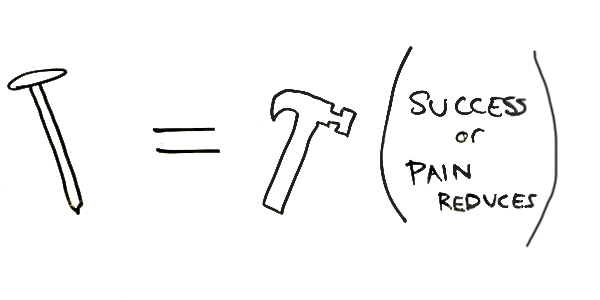
05 Dec Are You In Pain and a Victim of The Kitchen Sink Paradox?
If your pain has been lasting for more than three months, keep going. Read this post or watch this 3 minute video. Answers await you.
If you don’t a hear a tree falling in the woods, did it actually fall?
Quite the paradox.
If you throw the kitchen sink at your stubborn low back pain, annoying IT Band pain, frustrating shoulder pain, will it fix your pain?
You might be thinking:
Of course, the kitchen sink would fix my pain!
In reality, the kitchen sink often achieves no relief for many pain sufferers.
If you’ve been to 2 or more doctors or therapists for your pain, than you’re already a victim of the Kitchen Sink Paradox.
Keep reading to take the power back.
The Story of the Kitchen Sink Paradox
You have back pain.
So you go to a chiropractor, three times a week for a month, with 50% relief for 24 hours after every adjustment, only to have it come back to the baseline after the Irrelevant Pain Relief Window.
Next, you go to a physical therapist.
You get heat, electronic stimulation, decompression, strengthening exercises, myofascial work in the form of foam-rolling and massage, and advice for sitting at your desk. After 16 sessions, you’re 5% improved and your frustration is going.
Then, you see an orthopedic doctor.
He injects cortisone into your back and your pain is gone. “Hallelujah!” you shout. After two weeks, the pain returns.
Three doctors. Eight different therapies. You might as well add any other therapeutic techniques to our list to make it the world’s largest kitchen sink! Surely, your pain wouldn’t live up to that.
Alas, your pain will stand up to any treatment …
… that isn’t making your problem smaller.
Hammers work on nails.
Screwdrivers work on screws.
Wrenches work on nuts.
Take a screwdriver, a wrench, a saw, a bulldozer, and throw them at nails, trying to make them work, and you know as well as I do, that the kitchen sink will fail miserably.

There’s a Place Under the Sun For Every Treatment
Let me be clear.
I’m not saying the treatments listed above are bad in themselves. The fact that they exist proves their efficacy with specific individuals.
What I am saying is that throwing the kitchen sink at your problems is like shooting in the dark. You don’t even know what the problem is.
I believe that all doctors and therapists are doing the best they can with the knowledge they have. I don’t fault any healthcare provider.
However, I get frustrated when people are pulled along on a treatment plan that obviously isn’t working.
Sixteen visits with 0% improvement on a problem? That’s too long and unacceptable. It was obvious to me that it wasn’t working after five visits.
Tongue-in-cheek, I call it the “Kitchen Sink Paradox” because you, like so many people, may be wondering:
My doctors/therapists did everything for my pain! And none of it worked! I don’t get it?
Well, something was missing from your pain story.
You Need a Diagnosis. And It Needs To Be Correct.
IT Band Syndrome is the entrance to the rabbit hole.
The diagnosis of “IT Band Syndrome” does nothing to tell me what to treat as a Chronic Pain Resolution doctor.
So the ID Band is pissed off. Cool. Now, the question is why? Down the rabbit hole, we must go.
The list of tissue-specific problems that could be wrong, warranting different treatments in different places, for IT Band Syndrome goes well into the double digits. The amount of pain sufferers and pain fixers missing the mark indicates that something must change.
- Millions of people go to yoga classes in the western world, stretching their tight muscles, never to get any more flexible.
- Chiropractors typically treat 3-10% of the population and wonder how they can see more patients. In my mind, the answer is simple: Get more patients out of pain.
- Orthopedic doctors enjoy easy access to patients who seek them out based on our current level of medical consciousness. The blanket treatment of “Let’s inject cortisone in there and see what happens” is unacceptable healthcare.
The reality is that there is probably multiple problems causing your pain. And that certain problems deserve more weight than other problems.
A recent bout of “IT Band Syndrome” I treated contained this prioritized list of problems:
- Adhesion (glue) throughout her low back.
- Hamstring Weakness.
- (Probable) disc inflammation shooting “referral pain” out to her IT Bands.
After feeling her IT Bands, I noticed the texture of the muscle was irritated and ropy. However, I felt no adhesion or primary problems there. Because I didn’t feel a relevant problem, I didn’t even add it to the list.
With the diagnosis, I told her that the expected timeline for permanent, sustainable relief is five visits or less. Not sixteen. Not twenty-five.
Go Find Clarity
If you don’t hear the tree fall, you can go to where the alleged tree was supposed to fall, and observe, with your eyeballs, if, in fact, it did fall.
There’s a very real, objective way to find answers.
Similarly, you can test the kitchen sink with the long, diverse list of treatments.
The kitchen sink will work on occasion, although I may argue, depending on how long you’ve had the pain (if it’s acute or less than 2 weeks), that 4 out of 5 people will get better no matter what treatment you use.
However, that’s not a very good science experiment. The best science experiments change only one thing.
Kind of like a doctor or therapist who proposed to only start with your #1, top-priority problem, and remove it.
If the person who is currently over-seeing your pain doesn’t give you a rational, clear story of what they’re doing, find another doctor or provider.
 Are you a victim to the Kitchen Sink Paradox? How much time, energy, or money did you waste, confused by why so many treatments didn’t work?Please share in the comments below.
Are you a victim to the Kitchen Sink Paradox? How much time, energy, or money did you waste, confused by why so many treatments didn’t work?Please share in the comments below.

No Comments